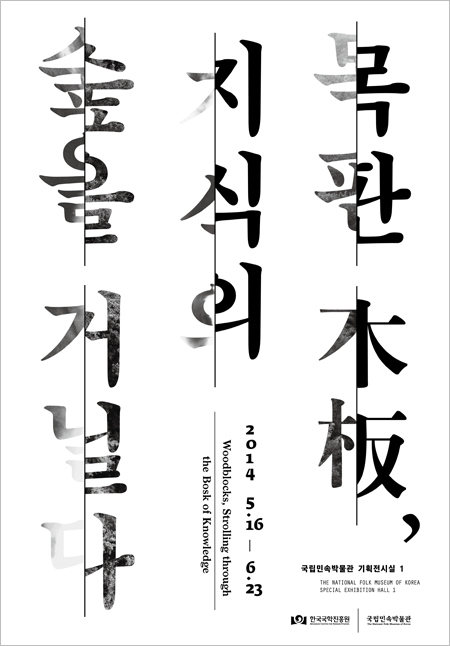Introduction
Our ancestors still communicate their ideas to us by means of their writings and paintings in woodblocks.The woodblocks provide not only information about their knowledge and experiences, but they also contain our ancestors’ philosophy. This is why the woodblocks are a significant part of the historical memory of our cultural heritage. Our ancestors made the effort to produce and preserve woodblocks to pass down their knowledge (or information) to future generations even under difficult circumstances.

The National Folk Museum of Korea (NFMK) and the Korean Studies Advancement Center (KSAC) co-present this special exhibition, displaying artifacts relating to our ancestors’ woodblocks from aroundSouth Korea, “Woodblocks: The Value of Knowledge.” The exhibition focuses on the transfer of knowledge and the preservation of woodblocks in an era of sophisticated information and technology. In addition, this exhibition shows the process of making woodblocks and how relevant they are to our contemporary lives.
We hope our visitors will understand the importance and value of woodblocks as part of the historical memory of our cultural heritage, as they follow the story told in the exhibition of how woodblocks have preserved that heritage for more than 100 years. Finally, we hope that the larger world will recognize their value in global terms value so that mankind will preserve our woodblocks for future generations.
I. Writing on Paper
Human beings express their ideas by speaking and behavior and the maintenance of written records. Thus, writing and printing on paper records the story and pictures the landscape of the world. Our ancestors analyzed their history, their contemporary problems and made plans for the future through such paper records.
In order to transfer their ideas to future generations, they wrote ideas word for word and drew things that they saw with black ink on paper. The books thus produced including all kinds of knowledge, could be duplicated and thus maintained across thousands of years until the present day.
II. Inscribing on Wood
Our ancestors inscribed writings and paintings on wood, on metal and on stone with the hope that they could be preserved for a long time. But they were especially devoted to the process of carving word for word on wood. The making of a book followed the printing process: the woodblocks were covered with black ink and a piece of paper was placed over them one after another. They sometimes described this kind of book production as similar to sewing elegant patterns on silk.
III. Communicating with the World
Completing books by this process required much care and effort.The use of woodblocks for making books made possible the publishing of many kinds of books--personal works, books onone’s family tree, books on geography and on medicine--and it allowed for transferring broad knowledge across time and space. For example, King Seonjo of the Joseon Dynasty (1567~1608) greatly respected the works of the scholar, Toegye
Lee hwang and said, “Every one of his writings was valuable to pass down to future generations. If we had not kept his works, we would have regretted it.” The King issued an order to inscribe Toegye Lee hwang’s works on wood.
Thus we see that woodblocks were a key way by which our ancestors transferred their wisdom and knowledge to future generations. The house of a sunbi (a member of the upper class) contained a jangpangak, in effect a publishing room where he kept engraving blocks and which constituted a kind of center for information and technology in his house.
IV. Continuing to the Present in Everyday Life
The woodblocks were not only used for making books to transfer serious knowledge, but they also were employed in various ways in everyday life in Korea. Additionally these foundations of our culture became a means for Koreans to express their artistic sensibilities.
Despite many national hardships, Koreans continued to respect the value their ancestors placed on the making of woodblocks by continuing the tradition, for example, to maintain complete records of one’s family tree to pass along to future generations. In addition, they used woodblocks for a hanging board in buildings, as wells as to process patterns pressed in rice cakes and sweets and gold and talismans in their daily life. As Koreans carved writings and patterns in wood to show their devotion or to express their best wishes, they continued to use woodblocks in their everyday lives. The woodblocks remain an important cultural element up to the present time.



